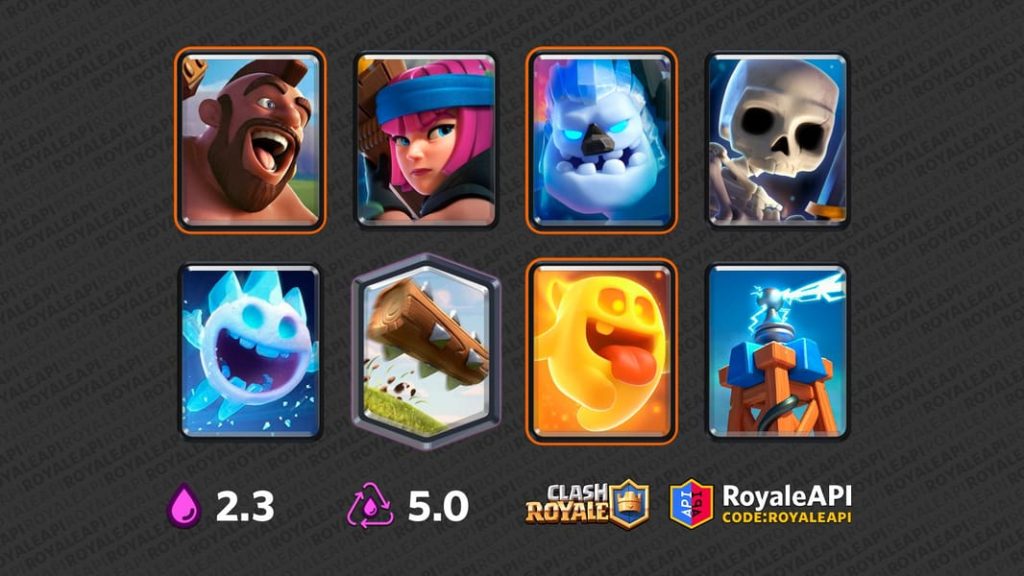Introduction
Clash Royale has seen many deck archetypes rise and fall in popularity over the years, but few have maintained the enduring appeal and competitive strength of the Hog Cycle deck. At its core, this deck revolves around rapid elixir generation, fast-paced offensive pushes, and tight defensive counters. The Hog Cycle deck is beloved by many players due to its simplicity in concept yet high skill ceiling in execution. Players who master this deck often find themselves with greater control over the game tempo and the ability to outmaneuver even the most expensive and high-damage strategies. As the meta continues to evolve into 2025, the Hog Cycle remains a fan-favorite and a go-to choice in both ladder and tournament settings. Please visit this.
Understanding The Philosophy Behind The Hog Cycle Deck

The Hog Cycle deck thrives on efficiency and speed. Unlike beatdown decks that rely on building massive pushes, the Hog Cycle emphasizes constant pressure and minimal elixir investment. This deck typically features the Hog Rider as its primary win condition, supported by a cast of low-cost cycle cards that allow the player to rotate back to the Hog quickly. Cards like Ice Spirit, Skeletons, and Cannon are staples in the traditional setup because they are cheap yet extremely effective when used with precision. The goal is to overwhelm opponents by not allowing them the time or elixir to build a strong counterattack. The cycle nature of the deck forces players to think several moves ahead, anticipating enemy placements and punishing mistakes swiftly.
The Core Cards In A Classic Hog Cycle Deck
The classic version of the Hog Cycle deck includes Hog Rider, Ice Spirit, Skeletons, Cannon, Musketeer, Ice Golem, Fireball, and Log. Each card plays a crucial role in maintaining pressure and defending efficiently. The Hog Rider is the main offensive tool, with its fast movement speed and tower-targeting behavior making it ideal for chip damage. Ice Spirit and Skeletons provide quick cycling while offering valuable utility for just 1 elixir. Cannon serves as the central defensive structure, strong against ground-based threats and heavy tanks. Musketeer provides long-range support against air units and synergizes well with Ice Golem and Fireball to control the battlefield. The Ice Golem serves as a cheap tank and kite unit, drawing enemies away from towers while absorbing damage. Fireball and Log offer reliable spell damage and crowd control, ensuring that the player can clear enemy swarms and support units during key moments of the match.
Gameplan And Match Strategy With The Hog Cycle
The primary gameplan with the Hog Cycle deck is to control the pace of the match from the start. Players should aim to get value from every elixir spent and look for windows to send in the Hog Rider when the opponent is low on elixir or out of key defensive cards. The early game usually consists of scouting the opponent’s deck and making cheap plays like Skeletons or Ice Spirit to cycle through cards and build elixir. Once the opponent reveals their counters, such as Tornado, Mini P.E.K.K.A, or Building, the Hog player must begin to predict and outplay those responses. This could mean pre-placing troops to bait out the counter or sending the Hog in at off-timings to catch the opponent off guard. Mid-game strategies focus on keeping pressure high, forcing the opponent to spend more than necessary on defense. Endgame, especially in double elixir, is where the Hog Cycle shines. With faster cycling, players can send two or even three Hog pushes in quick succession, overwhelming even the sturdiest of defenses.
Defensive Techniques And Counterplay
Defense is one of the most critical elements when playing a Hog Cycle deck. Given the lightweight nature of most cycle decks, they often rely on cheap units and smart placement rather than brute force. The Cannon, when placed correctly, is extremely effective at stopping Hog Riders, Giants, and even Royal Hogs. Skeletons and Ice Spirit are excellent for distracting units like Mini P.E.K.K.A, Bandit, or Prince, buying enough time for the tower and Musketeer to finish the job. The Musketeer, with her high single-target DPS and long range, is versatile enough to deal with flying units like Baby Dragon, Balloon, or Inferno Dragon. Spells like Log and Fireball can be used defensively to clear out swarms or knock back heavy troops. A key aspect of Hog Cycle defense is damage mitigation. Even if you cannot stop an enemy troop from hitting the tower once, minimizing the damage through kiting and placement can be the difference between victory and defeat.
Adaptations And Variations In The Hog Cycle Meta
As the Clash Royale meta changes, so too do the components of the Hog Cycle deck. While the classic version remains viable, several variations have emerged to counter new threats and adapt to evolving strategies. One popular variant includes replacing the Ice Spirit with the Heal Spirit, offering added value when paired with Hog pushes. Another includes the use of Earthquake instead of Fireball to deal with buildings like Tesla or Bomb Tower more efficiently. Bats and Electro Spirit have also seen use in place of Skeletons or Ice Spirit to improve air defense and stun capability. Some versions substitute Cannon with Bomb Tower or Tesla for stronger defense against swarm-heavy or ground-based decks. These adaptations reflect the flexibility of the Hog Cycle archetype, allowing players to fine-tune their decks according to their playstyle and the prevailing meta.
Advantages Of Using The Hog Cycle Deck

One of the biggest advantages of using the Hog Cycle deck is its low average elixir cost. This allows players to cycle back to their win condition faster than the opponent can typically counter it. It encourages a proactive playstyle, where players dictate the flow of the game instead of reacting passively. The deck also sharpens a player’s fundamentals, teaching them elixir management, placement precision, and timing. Because of the deck’s reliance on small mistakes from the opponent, it’s extremely satisfying to play and win with, especially against heavier, more expensive decks. Its versatility in ladder and tournaments makes it a consistent choice at all levels of play, from casual gamers to pro-level competitors. Whether you’re facing a LavaLoon push or a Golem beatdown, a well-played Hog Cycle deck can counter almost anything if the player executes it correctly.
Challenges And Weaknesses In The Hog Cycle
Despite its strengths, the Hog Cycle deck isn’t without its challenges. Because of its light nature, it can struggle against extremely fast decks with swarms or against well-defended siege decks. For example, X-Bow and Mortar decks can be tough to deal with if they out-cycle the Hog player and constantly apply pressure. Likewise, decks that include multiple counters to Hog Rider, like Tornado plus Goblin Gang or Mini P.E.K.K.A and Bomb Tower, can significantly limit your offensive opportunities. Another major challenge is the skill requirement. While the deck may look easy to pick up, mastering it requires fast decision-making, superior card placement, and excellent elixir awareness. It can also be unforgiving, as one misstep or over-commitment can lead to a devastating counter-push that the deck may struggle to defend. Players need to be adaptive and aware of their opponent’s cycle to consistently win with Hog Cycle.
Best Practices For Mastering The Hog Cycle Deck
To truly master the Hog Cycle deck, players must commit to learning the nuances of every card interaction. Practice is key—understanding how to kite enemy troops, when to sacrifice tower damage to gain an elixir advantage, and how to keep track of your opponent’s cycle are all essential skills. Watching professional replays or top ladder gameplay can provide valuable insights into timing and positioning. Training against common meta decks also helps players prepare for difficult matchups and refine their responses. Rotating through Hog Rider efficiently and knowing when to pressure the opposite lane can throw opponents off-balance. Constantly analyzing replays to see what went wrong and what could be improved helps in the long-term development of a Hog Cycle expert. Staying calm during high-pressure situations and avoiding over-commitment are also traits of a seasoned player.
Pro Player Insights and Tournament Usage

The Hog Cycle deck has seen extensive use in professional Clash Royale tournaments. Pro players appreciate its ability to control tempo and apply constant pressure. In events like CRL (Clash Royale League) and competitive ladder seasons, many pros keep a Hog Cycle variant in their lineup due to its reliability and balanced matchups. Top players like Morten, Surgical Goblin, and Lucas have showcased their mastery of the Hog Cycle in numerous tournaments, often turning games around with precise defense and aggressive Hog timing. These pro players often display advanced tactics like predictive logs, elixir counting, and pressure cycling, which can be learned and adapted by players seeking to climb the ranks. Tournaments also showcase how flexible the deck is when tailored to specific opponents, as pros adjust their support cards to counter specific meta threats.
Conclusion
Looking ahead to 2025, the Hog Cycle deck continues to be a pillar of Clash Royale strategy. Despite numerous balance changes and meta shifts, the core principles of the deck remain strong. Supercell’s ongoing updates and card rotations may introduce new elements to the game, but the Hog Rider’s utility and the fast-paced cycle strategy will likely remain relevant. Future innovations may include the integration of new champions or spells, or hybrid versions of Hog Cycle mixed with other archetypes like control or miner chip. The deck’s ability to evolve with the times ensures that it will stay competitive, offering both new players and veterans a rewarding gameplay experience.

